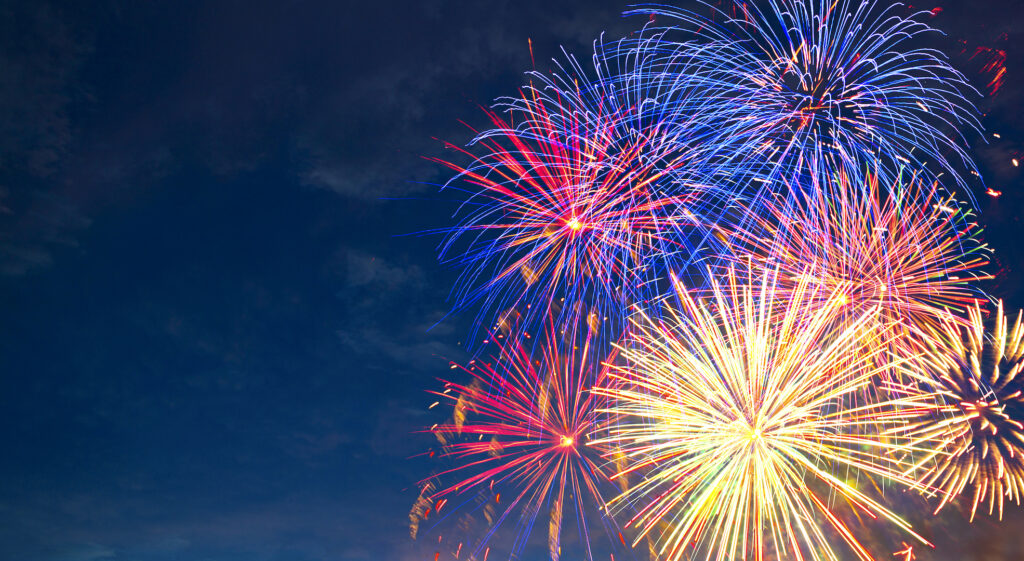
Five ways to fabulous fireworks photography! Fireworks season is fast approaching, and with it comes the opportunity to get some great photos. But this year, rather than just snapping away randomly, why not learn how to get the best fireworks photos you possibly can? Photos that you will be proud of and want to display in your home.
In this guide we will share five ways that you can do this. With just a little time, effort and preparation, you will have fireworks photos to be proud of!
It may seem strange to talk about the best setting for fireworks shots. After all, the action is all taking place in the sky so all you need to do is point upwards and shoot, right?
Well it’s not quite as simple as that. Whilst the fireworks are the main event, your shots will be much more interesting if they also feature other objects of interest in the frame as well.
So for example if you are in a built up area, try and find either a well-known landmark or an interesting building to include in the shot. This will bring some reference point and sense of perspective to the shot, and will offset the firework display perfectly. You can achieve a much more dramatic and in-depth shot by doing this. Similarly, if you are shooting in a more rural setting, look for trees or water to shoot near.
Whatever else is in the backdrop of your shot, it can also be very effective to include people as well. You can use them just to help fill the frame, or make them an active element of the photo by capturing expressions on their faces.
It is always challenging capturing fast moving objects, and fireworks are no exception to that rule. So it is especially important to keep your camera as steady as you can to avoid any additional blurring being caused by your camera shaking.
You may want to consider using a tripod, as this is the best way to keep your camera completely still. You could also use a remote trigger to operate the camera, so that you don’t have to remain as static as the tripod. The tripod could also help you to get shots from angles that are difficult to maintain manually but which could get better results.
There are many different types of tripod available including monopods – one-legged tripods – that are lighter weight than a normal tripod but still provide an amount of extra stability that could make a positive difference to your shots.
Many firework displays save the best till last. Whatever else happens in the show, the grand finale is what we are all waiting for. So naturally this will be the part you probably want to photograph most.
However, be aware that the longer the show goes on the more smoke there will be in the sky. Which means that it could be difficult to get good clear shots at this stage of the proceedings.
So you may want to get some good clear shots earlier on in the display, and go for a more blurry and ethereal look later on.
Both scenarios present an ideal opportunity to experiment with lenses and filters if you have them. For example, if you have a zoom or telephoto lens, you will be able to focus on various smaller details of the larger display. It’s definitely worth trying your lenses out at home beforehand so that you are confident in what you are doing and are able to achieve some interesting abstract shots.
Flash generally won’t help you to get better fireworks shots because of the brightness of the fireworks themselves. In fact, you could just end up with overexposed shots. Only use flash if you want this kind of effect, or if you want to light up subjects in the foreground of your shot – against the background of fireworks.
Otherwise, if you have a camera that defaults to flash, either switch it off from the menu settings or set the flash as low as possible and set the camera to Manual mode.
When planning how to get the best fireworks photos, ensure you use the power of the exposure triangle. The exposure triangle describes the relationship between aperture, shutter speed and ISO to get exactly the right combination of light for your shot. Set your camera to manual so that you can control these three settings.
We covered this topic in more depth in our recent article How to learn about photography, but as a brief guide try the following settings as a starting point:
The more you practise with your camera settings, the more confident you will become, and you will develop an intuitive understanding of the best settings to try in any given situation.
We hope that you enjoy the firework season this year, and that this guide from Print Your Memory helps you to understand more about how to get the best fireworks photos.
______________________________________________________________________________________